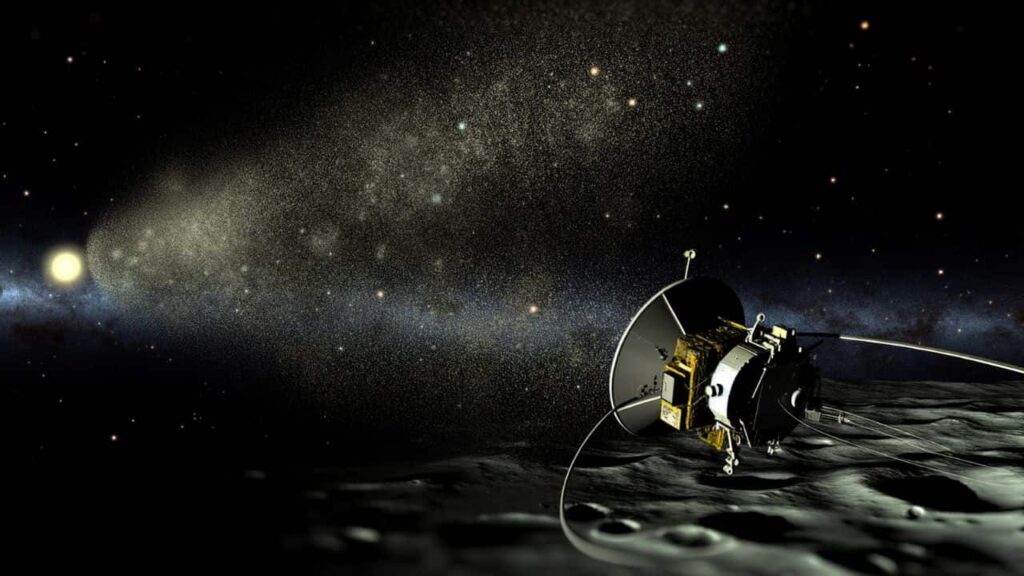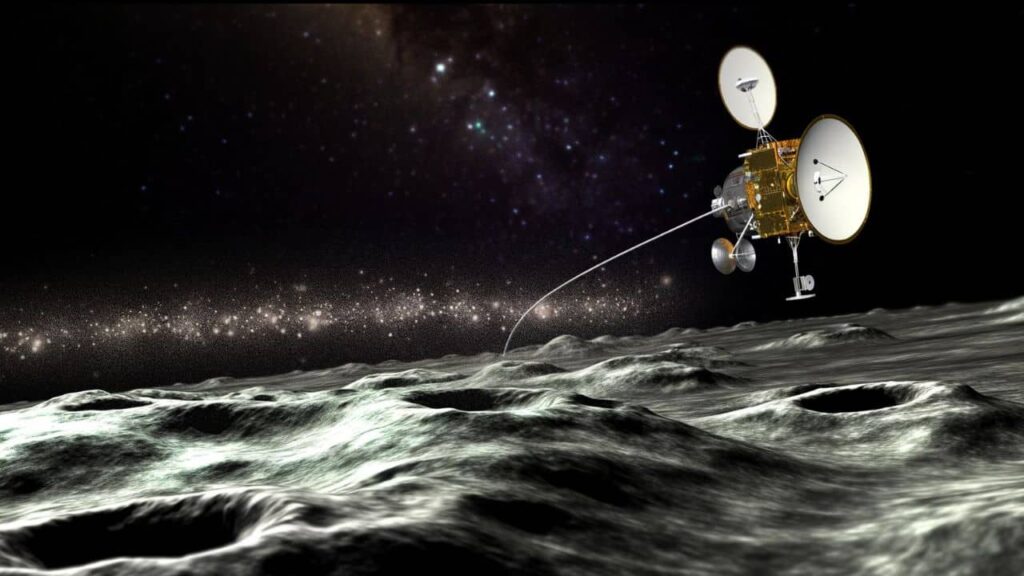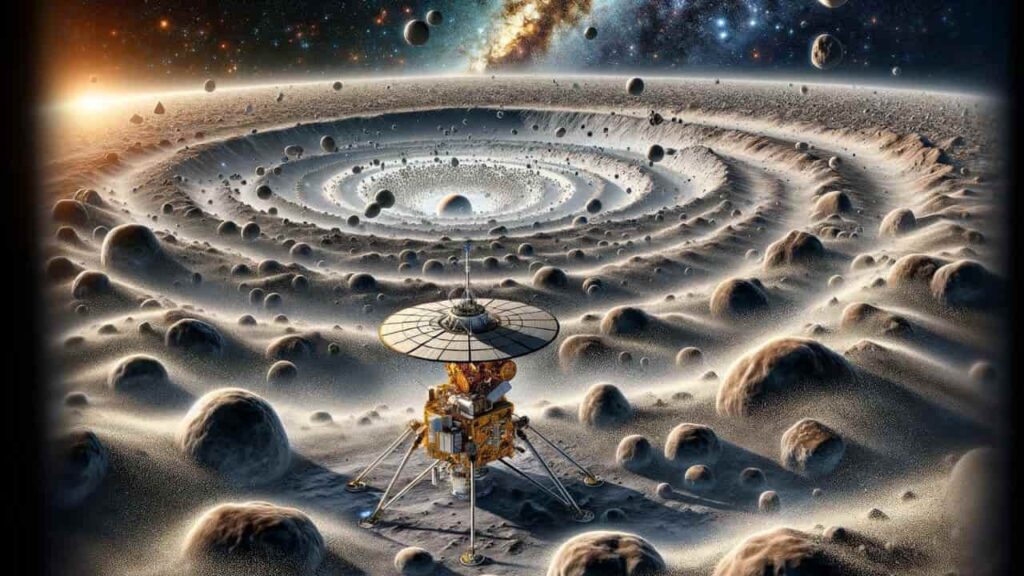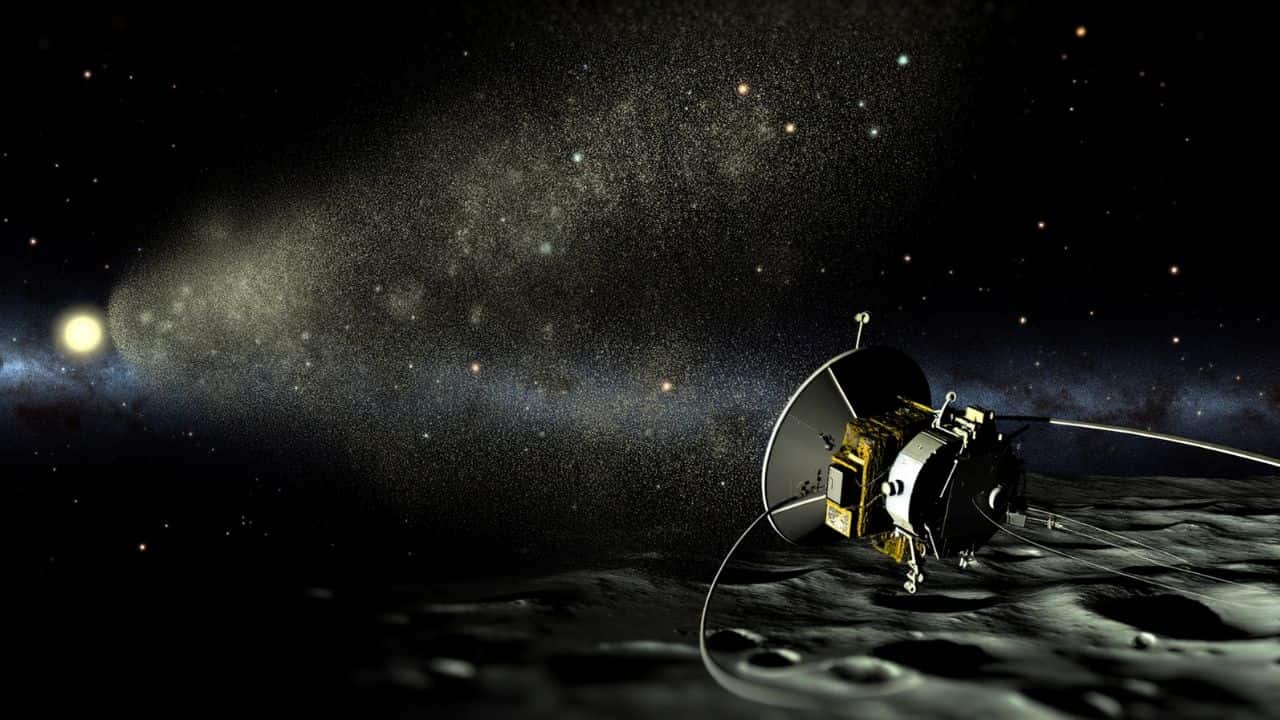“New Horizons spacecraft, Kuiper Belt, solar system exploration, NASA missions, interplanetary dust, Venetia Burney Student Dust Counter, outer solar system, astronomical units, space exploration technology, cosmic discoveries, extended Kuiper Belt, interstellar particles, astrophysical research, celestial bodies collisions, space science advancements”
NASA’s New Horizons Mission- The mysteries of the cosmos continue to unravel as the New Horizons spacecraft, a marvel of modern space exploration, sheds light on the Kuiper Belt’s true extent. This distant realm, teeming with icy, rocky objects that are the remnants of the solar system’s formation, appears to be far more extensive than previously believed.

Discovering a Dustier, Farther Kuiper Belt
The New Horizons mission, now nearly 60 times as far from the Sun as Earth, has revealed startling findings. The spacecraft’s Venetia Burney Student Dust Counter (SDC) has detected unexpectedly high levels of dust, suggesting that the Kuiper Belt extends billions of miles beyond its presumed edge. This discovery challenges existing models, proposing the existence of a second belt or an extended region teeming with objects and dust.
A New Frontier in Space Exploration
The findings, published in the Astrophysical Journal Letters, mark a significant milestone in space exploration. According to Alex Doner, the study’s lead author and a physics graduate student at the University of Colorado Boulder, these observations are among the first direct measurements of interplanetary dust beyond Neptune and Pluto. The potential discovery of an expanded Kuiper Belt hints at a vast, unexplored frontier in our solar system, offering new clues to its most distant regions.
The Role of the Student Dust Counter
The SDC, a pioneering instrument designed and built by students under professional guidance, has been integral to New Horizons’ journey. Traversing our solar system for over 18 years, it has meticulously counted and analyzed dust particles, shedding light on the collision rates of celestial bodies in the outer solar system. This instrument’s contributions are pivotal in understanding the dynamics of the Kuiper Belt and beyond.

Extending the Boundaries
The journey of New Horizons from 45 to 55 astronomical units (AU) from the Sun has been revealing. Observations made using ground-based telescopes, such as the Subaru Telescope in Hawaii, support the spacecraft’s findings, suggesting the Kuiper Belt might stretch to 80 AU or further. This extension challenges previous notions and opens new avenues for research and discovery.
Investigating the High Dust Levels
The high dust levels recorded by the SDC raise intriguing questions. Researchers are exploring various explanations, from radiation pressure pushing dust beyond 50 AU to encounters with transient ice particles. These findings not only enhance our understanding of the Kuiper Belt but also hint at the presence of previously unknown solar system bodies.
Looking to the Future
With New Horizons now on its second extended mission, expectations are high. The spacecraft is set to explore regions beyond 100 AU from the Sun, potentially entering an area dominated by interstellar particles. This mission offers an unparalleled opportunity to deepen our knowledge of the Kuiper Belt, interstellar dust, and the broader cosmos.
The New Horizons mission, managed by the Johns Hopkins Applied Physics Laboratory and led by the Southwest Research Institute, is a testament to human curiosity and the desire to explore the unknown. As part of NASA’s New Frontiers program, it continues to push the boundaries of our understanding, promising to uncover more secrets of our solar system in the decades to come.
Building on the initial exploration of the Kuiper Belt’s vastness through NASA’s New Horizons mission, it’s clear that this remote region of our solar system is more complex and extensive than previously understood. The mission’s latest discoveries suggest a frontier teeming with activity and potential for further scientific breakthroughs.

The Importance of the Kuiper Belt
The Kuiper Belt is a crucial area for understanding the solar system’s formation and evolution. Comprising millions of icy bodies, it serves as a reservoir of the solar system’s primordial remnants. Studying this region can offer insights into the processes that shaped the planets and the dynamics of early solar system development.
Expanding the Edges of Knowledge
The New Horizons spacecraft has been instrumental in expanding our knowledge of the Kuiper Belt. Its journey has not only provided evidence of an extended belt but also highlighted the complexity of dust distribution in this region. This challenges the previously held belief that the Kuiper Belt was a relatively static zone, altering our understanding of its dynamics and composition.
Scientific Implications of the Findings
The detection of higher dust levels by the SDC and the potential discovery of a second belt or extended region have significant scientific implications. These findings suggest a more active Kuiper Belt than anticipated, with implications for our understanding of comet origins, the distribution of small bodies in the outer solar system, and the potential for unseen objects influencing these dynamics.
The Role of Technology in Discovery
The success of the New Horizons mission underscores the importance of technological innovation in space exploration. The SDC’s design and operation by students highlight the valuable contributions of educational institutions to space research. This collaborative approach between students and professionals has paved the way for groundbreaking discoveries and inspired future generations of scientists and engineers.
Future Exploration and Research
The extended mission of New Horizons promises to unveil more about the outer reaches of our solar system. As it ventures beyond 100 AU, the spacecraft is poised to encounter regions where interstellar particles may predominate, offering a unique perspective on the interaction between our solar system and the broader galaxy.
Moreover, ongoing and future telescopic surveys from Earth continue to complement spacecraft observations. These efforts are crucial for identifying new Kuiper Belt Objects (KBOs), refining our understanding of the belt’s structure, and assessing the potential for habitable environments on these distant worlds.
Conclusion
The revelations from NASA’s New Horizons mission have not only expanded our understanding of the Kuiper Belt but also underscored the endless potential for discovery within our solar system. By challenging existing models and opening new avenues for research, these findings highlight the dynamic nature of space exploration. As we continue to probe the farthest reaches of space, the Kuiper Belt remains a key area of interest, promising to unravel more mysteries of our cosmic neighborhood.
Other Links-
